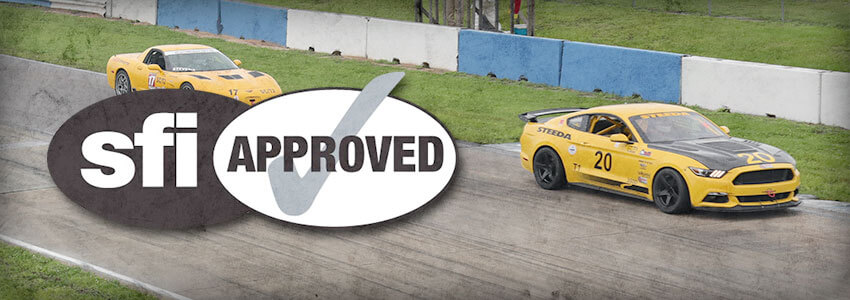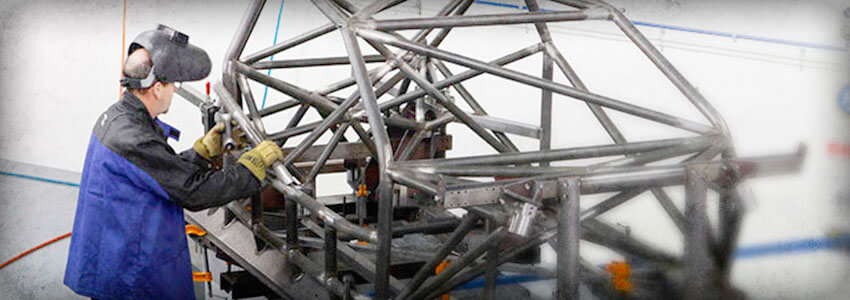Chances are if you are racing your Mustang on the road course, autocross, or the drag strip, you need the
best safety equipment to ensure you will be safe in case of an accident. If you have ever bought a
racing helmet, fire suit, driving gloves, and or a bolt-in roll
cage, you may have seen the SFI certified sticker or logo on the product. Just as there are sanctioning
bodies for racing series and events, safety equipment regulations certify safety; they are known as the
SFI Foundation, also known as the (SEMA Foundation Inc.). The SFI is a non-profit organization
established to administer standards and rules for
specialty performance and racing equipment components to ensure quality since 1978. The value that the
SFI adds to the automotive and racing industry is priceless because, without it, we wouldn't know what
is safe enough to use while out on the racetrack. In racing, safety is the number one priority
regardless of any racing sanctioning body, including SCCA, NASCAR, NHRA, and NMRA. The value-added services that SFI provides quality, certifications, and testing criteria for use in
motorsports. They strive to put the very best forth of equality and standards to serve manufacturers,
consumers, sanctioning bodies, racers, and government agencies through respect, efficiency, and fairness
to all. To accomplish this, the SFI uses specific procedures to ensure the equipment manufacturers and
racers alike have products tested and certified to industry standards. When an enthusiast or racer has
complete confidence in their equipment that will ease the pressure, they will be safer in a racing
environment. To understand how SFI further tests and grades products throughout the automotive and racing industry for
safety and quality standards, we must look at how they go through each testing process. Whereas SFI was
established in 1978 to begin safety standards in the industry, they didn't have their laboratory to test
products and industry standards until the turn of the century in 1999. Located in Escondido, California,
it is there to serve the needs of all SFI affiliated manufacturers that are seeking to test their
products in an effective and cost-efficient way. Each testing procedure is devised in a way to simulate
actual real-world scenarios in a controlled environment. Furthermore, to understand how each product is tested, SFI does a series of tests. To accomplish this, we
will examine how race suits are tested; technicians will use what is known as a Thermal Protective
Performance (TPP) machine, which conducts heat vertically and horizontally in a cabinet which is at
five-hundred degrees Fahrenheit. The reason to do this is so that SFI can test personal protective
equipment such as shoes, gloves, and driver suits. Also, they try for non-protective equipment,
including carbon fiber interior components and shifter boots for flame resistance. Not only does SFI test for flame resistance, but they also test for many other components, including
safety harnesses, which is a very vital component to any Mustang or racecar. More than fifty seatbelt
manufacturers come to SFI to have their belts tested for rigidity and strength. They will use a machine
that will put them through a series of scenarios for retention and strength quality to keep racers
harnessed in their seats at all times. They are primarily known for testing personal protective
equipment, and helmets, but they test for the following products and components in the automotive
industry: Suppose you're participating in a sanctioning body racing event; chances are there will be a tech
inspection for your Mustang or racecar to ensure everything is properly functioning and to ensure
safety. These are achieved when each racer meets with a tech inspector at the track, where they will run
down a series of guidelines they have to follow to certify your vehicle is ready for competition and can
run safely in the race. For example, suppose your Mustang battery or serpentine belt is not correctly
working in order and installed. In that case, they can disqualify you from running in the event because
the vehicle has safety issues, and it can be a safety hazard for others on the track. For each sanctioning body, a different set of guidelines and rules that tech inspectors must follow to
certify equipment within a class or segment of each racing organization for fairness and equality. In
recent decades of pushing for safety and regulations, manufacturers and tech inspectors have a much
easier job of knowing what is safe on and off the race track than if they had to inspect it upon
themselves. Racing has become easier to access for all Mustang and automotive enthusiasts thanks to the
SFI and their integral part in putting safety standards first at every automotive and racing component!
What Is Tramlining & How To Solve It On Your S550 Beginners Guide To Modifying Your S550 Mustang How To Change Your Mustang Oil & Filter Source Credit: SFI Foundation, IncWhat Is SFI Certification?


Safety Standards

Certified Equipment & Inspection
Related Articles





